Welcome to Old School Month on Eternal Central. We’re looking at a different Old School 93-94 deck each day of the month. Today’s deck is Naya Bazaar Zoo, named for playing an aggressive “Zoo” deck (with lots of creatures), in the Naya (Red-White-Green) colors, and utilizing Bazaar of Baghdad (more on that later).
This is a deck that seeks to be as low to the ground as reasonably possible, in order to get under countermagic, and to play a threat on the first or second turn, and then follow it up with removal and more threats until the opponent is dead, as fast as possible. The idea behind this when I originally constructed it was to abandon Erhnam Djinn and nearly every other card in Zoo decks above three mana, to play fewer mana sources, and create more room for removal and burn spells. This puts a stress test on opponents, to see if they can keep up with the speed and tenacity of a very quick and aggressive strategy, and this color combination provides the best mix of cheap pin-point removal.
Here are a couple of versions I have played over the past year at various events and local get-togethers.
2nd (5-2) out of 22 ppl at Chicago #OldSchoolMTG #PartyOfThePitLords with WRG Bazaar Zoo. Entrance = a toy donated to @CCOLife for children. pic.twitter.com/smSvzEOggQ
— Jaco (@JMJACO) December 4, 2016
Chicago #OldSchoolMTG hosted 2 tournaments in Madison this weekend (93-94 22 players & 95 17 players). Played RGW Bazaar Zoo to a T8 in both pic.twitter.com/w7kvnZqkQc
— Jaco (@JMJACO) January 30, 2017
Constructing Naya Bazaar Zoo
With any Zoo deck, you’ll want a mix of creatures, removal, burn spells, mana, and that’s mainly it. How many creatures vs. removal spells you play is up to you. Unlike most Zoo decks though, this one has a fairly robust (but compact) draw engine. Here is the latest version from the lab (as of this writing):
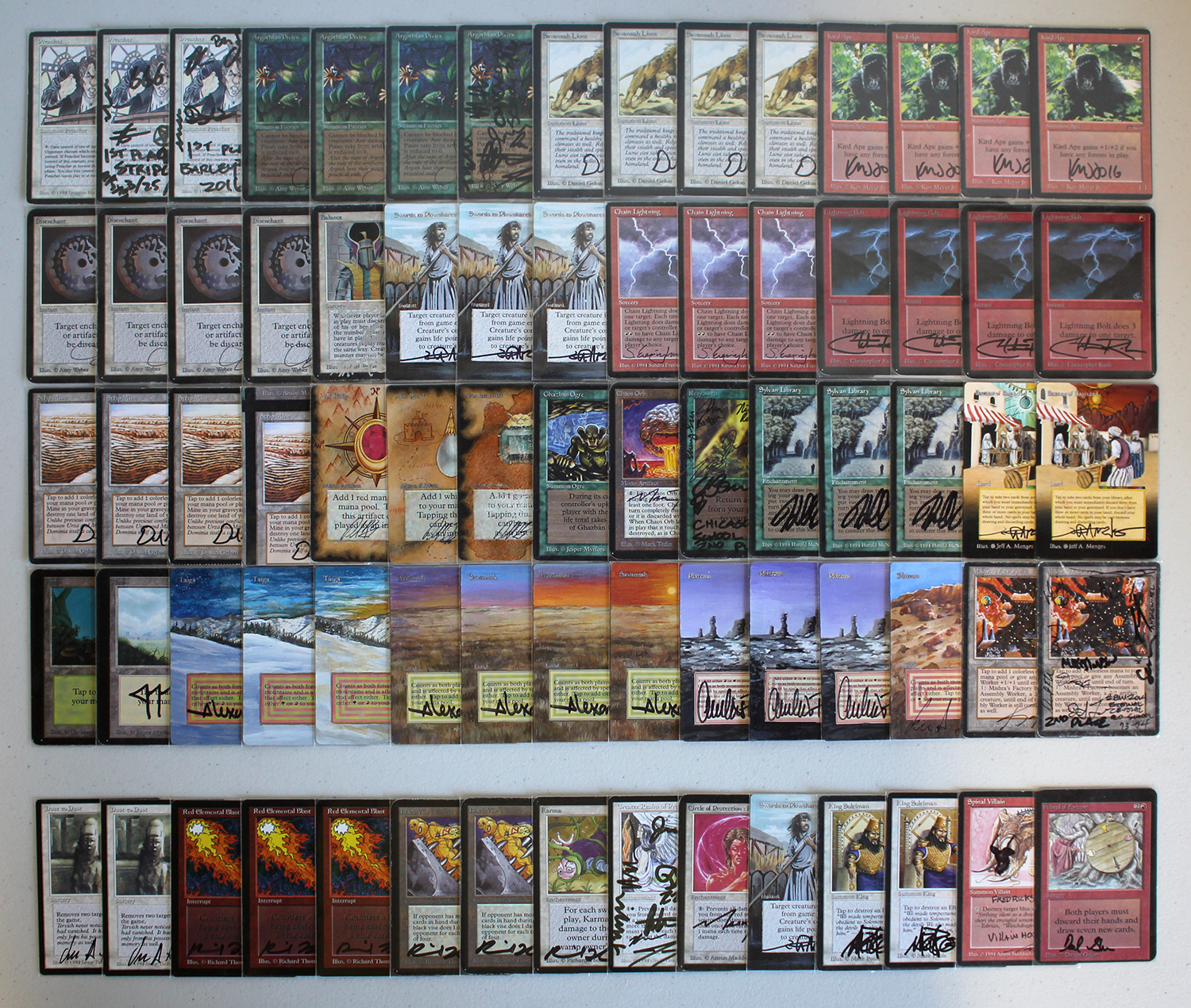
Creature Choices
If the goal with a stress-testing aggressive deck is to reliably hit a first and/or second turn threat, it follows that we’d like to play as many of these as we can, while also playing the best creatures available at those mana costs. Kird Ape is the most efficient one-drop available in 93-94, and Savannah Lions is the second best, so this naturally puts us in to the Red-White-Green color combination. Playing 4 of each of those creatures gives us 8 one-drops, but I’d like one or two more in the deck to more reliably find and play one on the first turn.
Ghazban Ogre is an often overlooked card from Arabian Nights that fits the bill, as a 2/2 for just a single mana. It has a conditionality that can provide a serious drawback, so playing more than one or two copies is probably ill-advised. It is a weak card against Lightning Bolt decks, but pretty strong against Blue-White control decks.
Naf’s Asp isn’t technically a 2/x creature, but also has the potential to do two damage a turn, so also bears slight scrutiny for this deck.
Another consideration as a playable 1-drop is Icatian Javelineers, which is only a 1/1, but serves as more creature control against other fast creature decks, like White Weenie and Pink Weenie. It can also combine with a Chain Lightning or Lightning Bolt to take out creatures with 4 toughness, such as Serra Angel, Serendib Efreet, and Su-Chi. Cast your burn spell at the target first, and once it has resolved and done 3 damage to the target creature, then tap Javelineers to activate to throw the lethal javelin through the heart of your enemy.
Argothian Pixies sits at two mana, but can reliably attack through opposing Mishra’s Factories, so it gets the nod here. It is also useful because it can block Juggernaut, Su-Chi, and Triskelion all day long.
Elvish Archers and Citanul Druids are other options that can be included, depending on your metagame. Archers is better against other weenie decks because of the first strike ability, while Citanal Druids is strong against artifact-laden decks.
King Suleiman is another card I like in this deck, as it’s right on curve, and can simply tap to destroy a Djinn or Efreet. With Serendib Efreet, Erhnam Djinn, and Juzam Djinn being so central to the 93-94 format, King Suleiman should not be overlooked. I typically like it in the sideboard in wide open metagames, but it can definitely be played main deck if your area features a lot of Arabian Nights creatures.
Rounding out the main deck creature package is Preacher, one of the only cards in the deck above two mana. Three mana for a 1/1 is pricey for this deck, but Preacher just changes the combat math so radically that it is usually worth playing main deck. Not only can it grab bigger creatures and provide additional control, but against pseudo-creatureless decks like The Deck it can nab a Mishra’s Factory should your opponent dare to activate it. Preacher really is a great card for this reason, and at the very least it’s another attacker on an empty board, if the opponent chooses to slowly play around it, by not playing more creatures (which could be jacked by Preacher).
One more creature I like to experiment with in here is Orcish Artillery, which serves as yet another aggro-control creature. It can clear out opposing threats on the ground, or provide those last few meaningful points of damage against someone who lands an uncontested Moat. If left unchecked against an opposing Zoo or weenie deck it will dominate the battlefield. This falls along the lines of Preacher, but can handle fewer creatures, so because of the three mana casting cost, coupled with the fact that I want it against fewer decks, I tend to slot this in the sideboard of Zoo when I play it.
Draw Engines
Sylvan Library is the best unrestricted Green card in Old School Magic, and as you’ll frequently read on Old School Month here, it helps smooth out draws, and more selectively dig for answers, threats, and mana sources. Its effect at reducing variance cannot be overstated for Old School, and it is the closest thing to Sensei’s Divining Top available in the format.
Bazaar of Baghdad is probably the card in this deck that draws the most questions and odd looks. For a deck with little other card draw, and that constantly empties its hand on curve, Bazaar can seem a bit odd at first glance. But consider what it does in this particular deck. At the cost of a land drop it can be used to uncounterably draw cards. It can convert dead, mediocre, or situational cards in hand in to more live draws, whether that be another threat, another piece of needed removal, or simply more burn spells to finish off the opponent. So it is never really dead on its own, and allows this deck to play a ton of situational spot-removal spells. As the saying goes, there are no incorrect threats, only incorrect answers, and Bazaar helps to mitigate that truism by cycling through your deck to find the correct answer or threat. But where Bazaar really shines is when used in conjunction with Sylvan Library. You can use Sylvan to find the card(s) you need, cast them, and then on your opponent’s end step activate Bazaar of Baghdad to clear away the remaining chaff from the top of your deck. On your next draw step you will be able to see three new cards, and you can repeat this process each turn, resulting in card selection and filtering that’s far superior to anything else available in 93-94. Having played this deck a lot, I believe 2-3 Bazaars is the right number for the deck, as you don’t want too many of them early, but playing it from about turn three onwards and cashing in extra unneeded land drops in favor of more threats and burn is the most common scenario.
Wheel of Fortune is a card that vacillates anywhere from main deck to completely out of the 75, depending on what I’m expecting to face, and how many burn spells I play. Against a lot of decks you just never want to cast it, because you’ll be ahead on board already, and casting it will simply allow the opponent more outs to find that critical Balance, mana acceleration, or another card they need to get back in the game. For this reason I tend to play it in the sideboard now, if at all, where I want the chance at some explosive draw power (like against Hymn to Tourach decks). Without a ton of fast mana, this deck lacks the ability to “go broken” with Wheel of Fortune.
Constructing a Mana Base
As mentioned above, this deck intentionally plays much less mana than other decks in the format, and does so because the mana curve is so low. The extra slots that would otherwise be used for more mana and acceleration are instead used on more burn and removal spells.
Strip Mine is essential to this deck for the tempo it can create with your cheap threats. Just using a Strip Mine on the first or second turn before you have a threat on the board is often the wrong play, and one I see people make repeatedly. You aren’t really generating any tempo with a wasted Strip Mine, and the only merit to doing so would be potentially shutting off the opponent from getting to a specific mana range (for example, hitting 4 mana to cast Jayemdae Tome, The Abyss, or some other problematic permanent), or hamstringing them on a specific color of mana you’re concerned about.
Aside from Strip Mine, Plateau is the most important land in the deck, as it can cast all of your removal and burn spells. Taiga and Savannah are obviously important as well, especially for ensuring you have a Forest in play when Kird Ape arrives. The mix of these you play is up to you, but I prefer to lean more heavily towards White than any other color, because the only spells in the 75 that require a double mana cost of any color are all White (Preacher and Dust to Dust, and maybe Karma, should you choose to run that in the sideboard).
I like a couple of basic lands in this deck, simply as an out to Blood Moon. When playing against a Blood Moon deck, it is often correct to sandbag these in hand until you need them, so that they do not get Strip Mined before your opponent drops Blood Moon.
Even though Library of Alexandria is a great card, it does not have a home in this deck, as your role is going to be the aggressor, and you’ll constantly seek to play threats on turns one and two, even in sideboarded games. Bazaar of Baghdad essentially fills the Library role in this deck, as detailed above.
Mishra’s Factory is another logical inclusion, but you must balance how many colorless mana sources you’ll wish to play. Playing 4 Factories here is likely a mistake, because when combined with Strip Mine, that’s 8 colorless lands in a deck that needs to reliably be hitting specific colored mana on turns 1 and 2 to cast its threats on curve. I like 1-2 Factories in here as additional uncounterable threats. If you are in an area that only allows a single Strip Mine, this deck is going to be significantly hamstrung, but you can play some additional Factories in those newfound card slots.
As far as acceleration goes, I prefer the on-color Moxen, and that’s it. Off-color Moxen really only help to accelerate out something like Sylvan Library, and don’t provide much else, because the mana curve is intentionally very low in this deck. Likewise, Black Lotus is an average card at best in the opening hand, because you’re not really accelerating in to anything large. It is also a miserable top-deck, so after testing it a decent amount, and often sideboarding it out, it has been cut from the deck altogether after the first few iterations of the deck were played. You’d basically just always prefer to draw a repeatable mana source instead of Lotus in here.
Designing the Sideboard
Red Elemental Blast is a versatile answer to blue cards in The Deck and UR Counterburn, as well as a great card against RUG decks, because it can answer anything from Ancestral Recall to Serendib Efreet.
Dust to Dust is three mana, but is a critical answer to artifact aggro decks, and to the fast mana and Jayemdae Tomes from The Deck and UWx control variants. Divine Offering is another option, but if I’m bringing in a card like this I’d prefer it to also gain some kind of card advantage or provide higher upside, and Dust to Dust does that.
Against creature-heavy decks you have many options to consider, but I usually bring in some mix of Chain Lightning, Preacher, King Suleiman, and Spinal Villain. These all ring in at one to three mana, and can either help out-tempo the opponent, or provide a significant recurring advantage. RUG decks are one of the only matchups that feels like you need help, and all of these are great additions against those.
Greater Realm of Preservation and Circle of Protection: Red are nice answers to UR Counterburn or Mono Red strategies, and can help save some of your life in a protracted battle, where you can eventually hope to squeeze out the last remaining life points. Circle of Protection: Black is also useful against the black-heavy creature decks, as well as Underworld Dreams. Keep in mind that each card drawn triggers Underworld Dreams separately, and thus each damage must be prevented separately with Circle of Protection or Greater Realm.
Karma is the only card that’s above three mana that I would consider playing anywhere in this 75. It is above the mana curve we are aiming for, but the effect that it can have against grindy Black/X decks is outsized, and that’s really what I’m looking for in sideboard cards. Effects that can have a lot of upside, and won’t be dead in multiples. Karma can be a game-ender on its own, even if the prepared opponent can kill off all of your other creatures.
Black Vise is an interesting solution to decks that want to play the Ivory Tower game, and feebly sit behind a pillow fort. It is not a great card on its own in here, but has some narrow uses that often make you want to have access to a few copies from the sideboard.
Playing Naya Bazaar Zoo
This is a tempo deck at heart, with the cheapest creatures, most efficient removal, and burn spells to close out the game. I like to aggressively remove my opponent’s creatures and attack through, but you must balance using which removal spells on which threats, and if it is worth taking one or more turns off of attacking to find the right answer for what might be a protracted skirmish. Do you use a Lightning Bolt on the opponent’s Mishra’s Factory, or a Swords to Plowshares, or do you wait to find and cast a Disenchant, which might otherwise be less useful against your particular opponent? These are things that you will discover with experience playing the deck.
Ten Opening Hands with Naya Bazaar Zoo
Here are ten randomly drawn opening hands with the deck (in order, and not manipulated in any way), and a few brief words with how I might look to play said opening hands.
Opening Hand 1
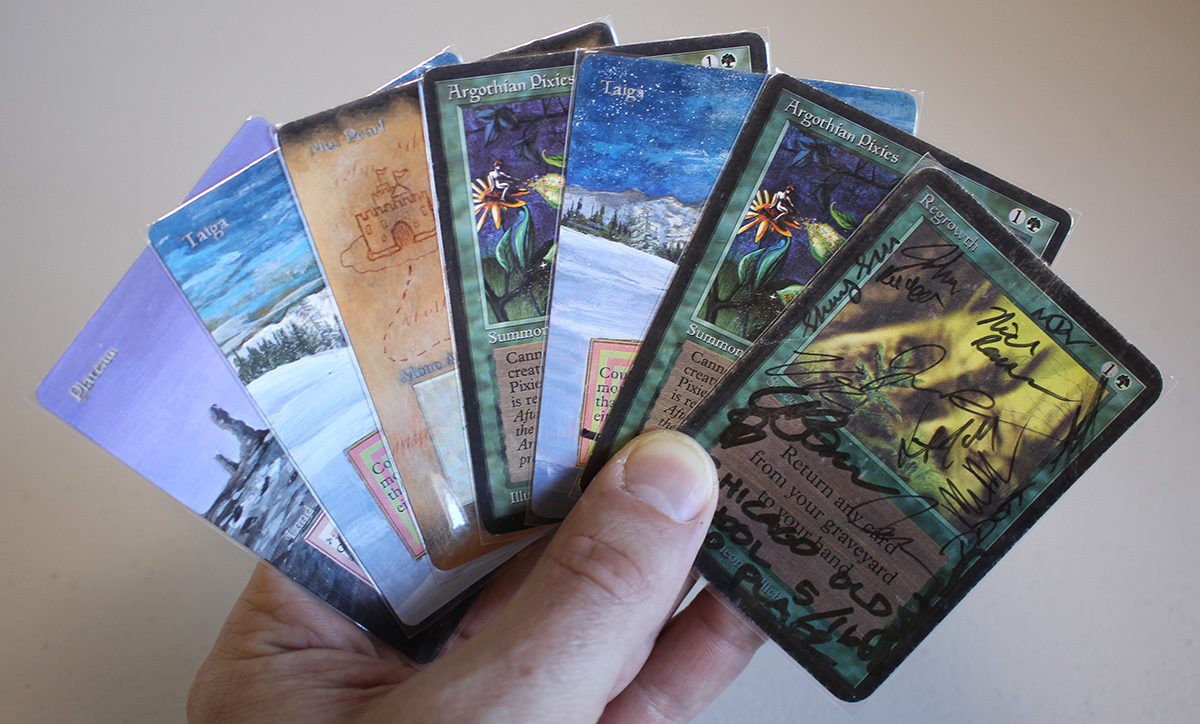
With plenty of mana, and the capability to play threats on turns one and two, followed by Regrowth later in the game to rebuy something important, this is an easy keep.
Opening Hand 2

This is a common type of opening hand with Zoo, featuring removal, a creature, and mana. This hand illustrates why sequencing and carefully considering your land drops are important, while also trying to map out coming turns ahead of time. While both Plateau and Savannah can cast Savannah Lions, deploying the Savannah first will let you play Mishra’s Factory on the second turn, and still have the mana to cast Sylvan Library. This will in turn set up the following turn, where you can likely find another threat, removal spell, or Strip Mine from the Sylvan draw, and then utilize that Strip Mine or your Swords already in hand, all while having the correct mana to attack with Lions and Factory on schedule. This uses all of your resources most efficiently each turn.
Opening Hand 3
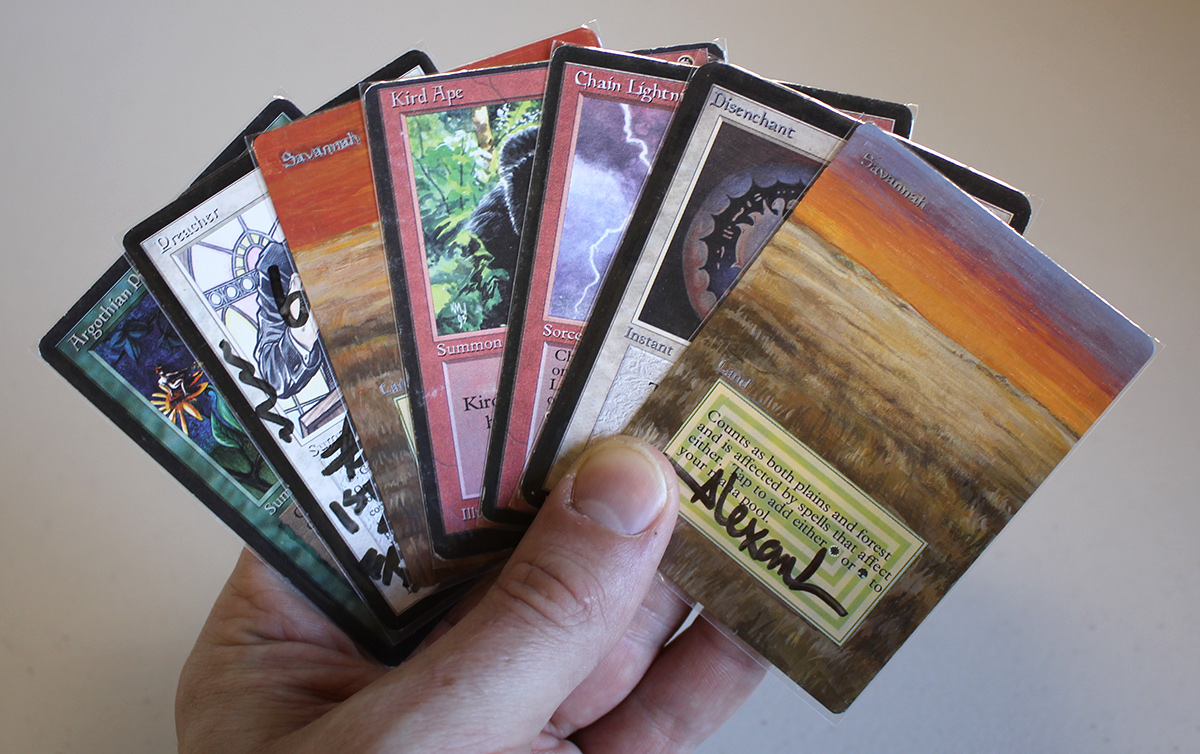
While this hand doesn’t have a turn one play, it does have the mana to cast a couple of different cards on the second turn, as well as removal and creature control. If we draw a red mana source soon, all the better, as both Kird Ape and another removal spell will be unlocked. I’d probably keep this, knowing it’s slightly risky, but that it contains high upside and flexibility.
Opening Hand 4
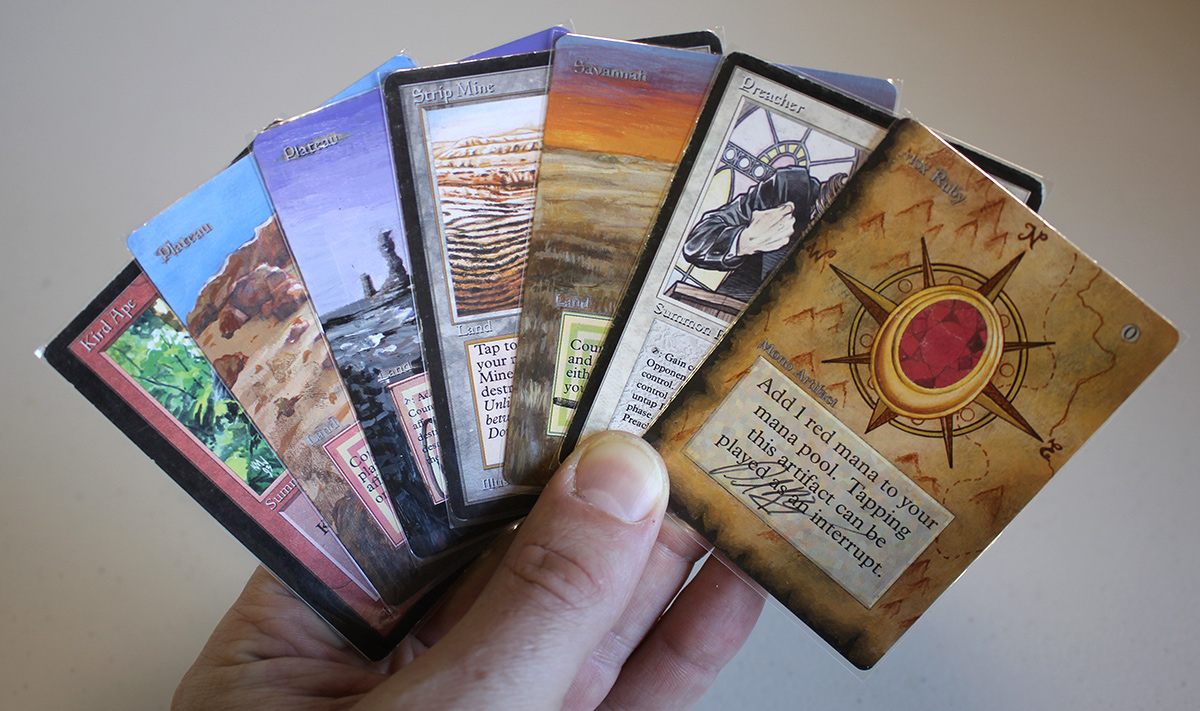
With a first turn Kird Ape, backed by Strip Mine, as well as plenty of on-colored mana, this hand is pedestrian, but workable.
Opening Hand 5
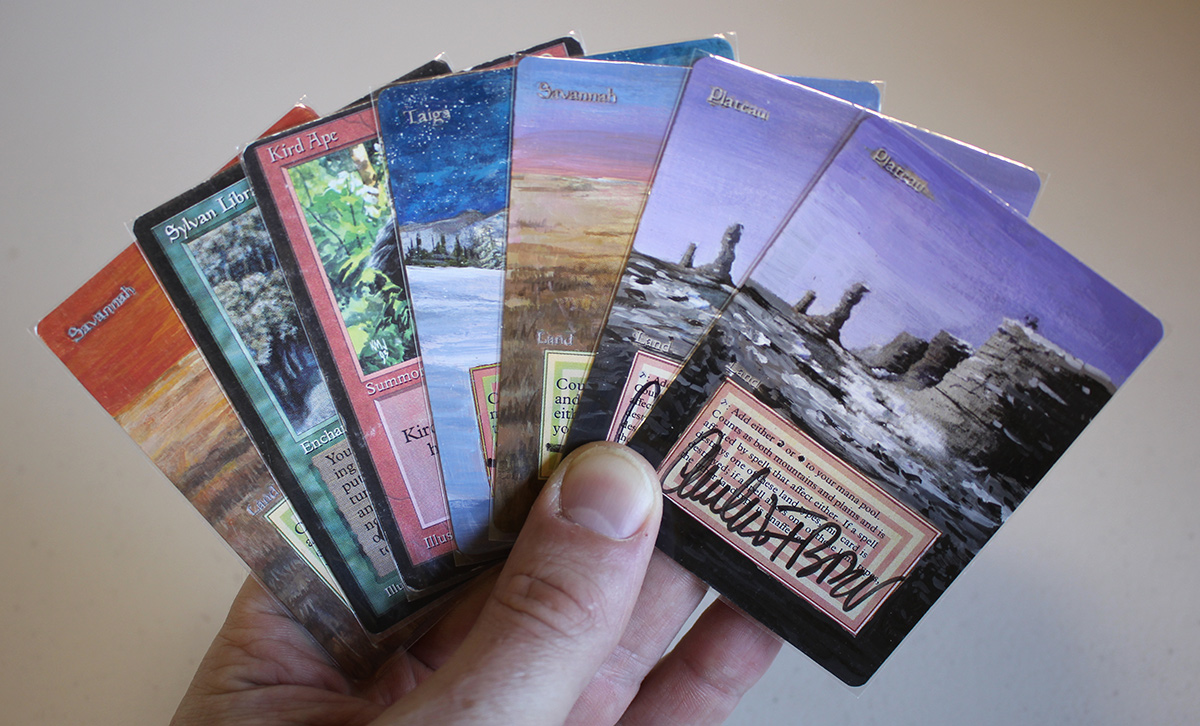
Lacking removal, this hand doesn’t seem very impressive. But it has all of the mana we are likely to need for the rest of the game, and can cast a first turn Kird Ape, followed by a second turn Sylvan Library. This is good enough to keep, and we’ll be searching for any action or a Bazaar with the Sylvan, and it’s probably worth using Sylvan aggressively here (meaning taking at least one extra card early), in order to dig deeper and use this abundance of mana.
Opening Hand 6
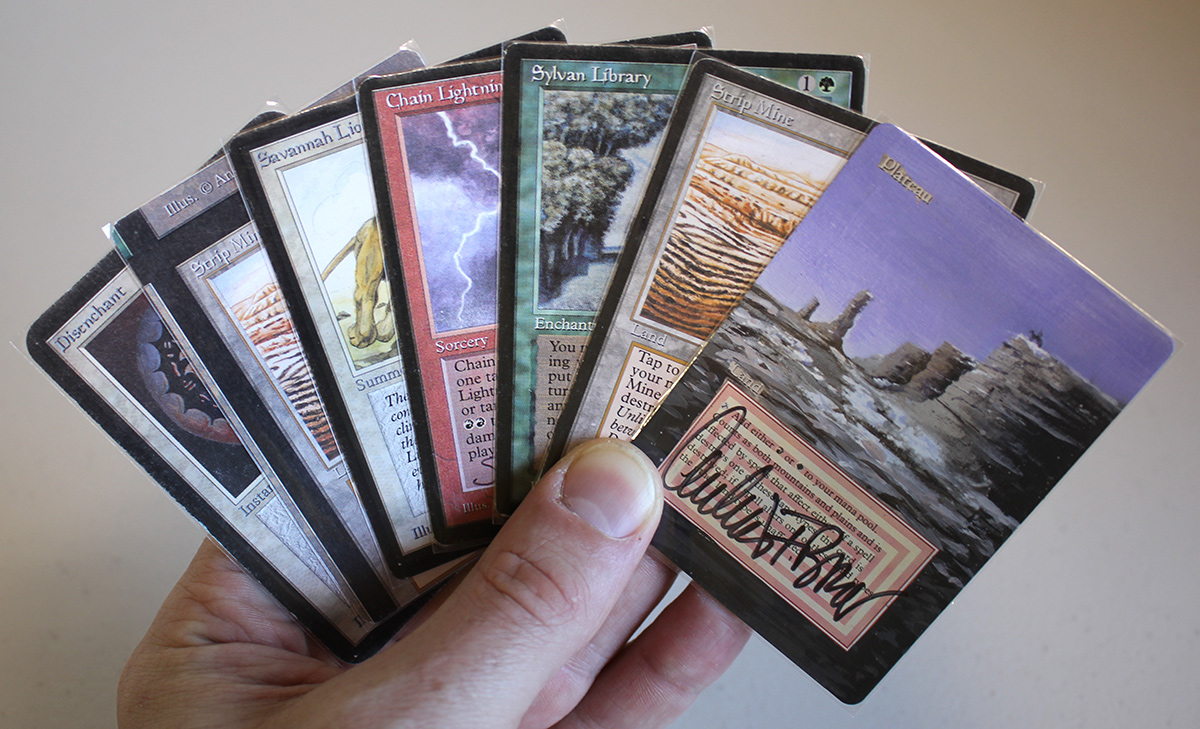
Featuring a one drop creature, multiple Strip Mines, and multiple removal spells, this is a keeper. We’ll need to draw a green source to get Sylvan online, but we likely have a few turns of doing other things spending our mana, such that we have time to find a green land.
Opening Hand 7

This hand is light on mana, but has the mana to cast most of it (outside of Preacher), as well as Sylvan to draw more mana and threats. Mapping out your first couple of turns requires some analysis and guesswork as to what your opponent can do here. If they play multiple Strip Mines I’d likely lead off with Sylvan on the first turn, in order to find more mana and to deploy multiple threats on the second turn. If they don’t, or if you suspect they have Disenchant and the mana to cast it that turn before you can untap, the correct play is Argothian Pixies (instead of Kird Ape, as this more efficiently uses your mana that turn, and could potentially allow you to cast Ape + Sylvan on the next turn if you draw a mana source).
Opening Hand 8

With Plateau as the only colored mana source in hand, this hand is a challenging one to grade. With the ability to cast multiple removal spells, as well as a threat (Factory) in hand already, Bazaar is what probably makes this hand a keeper. It can be used to cycle away whatever cards you might not need, and to find more mana or threats.
Opening Hand 9
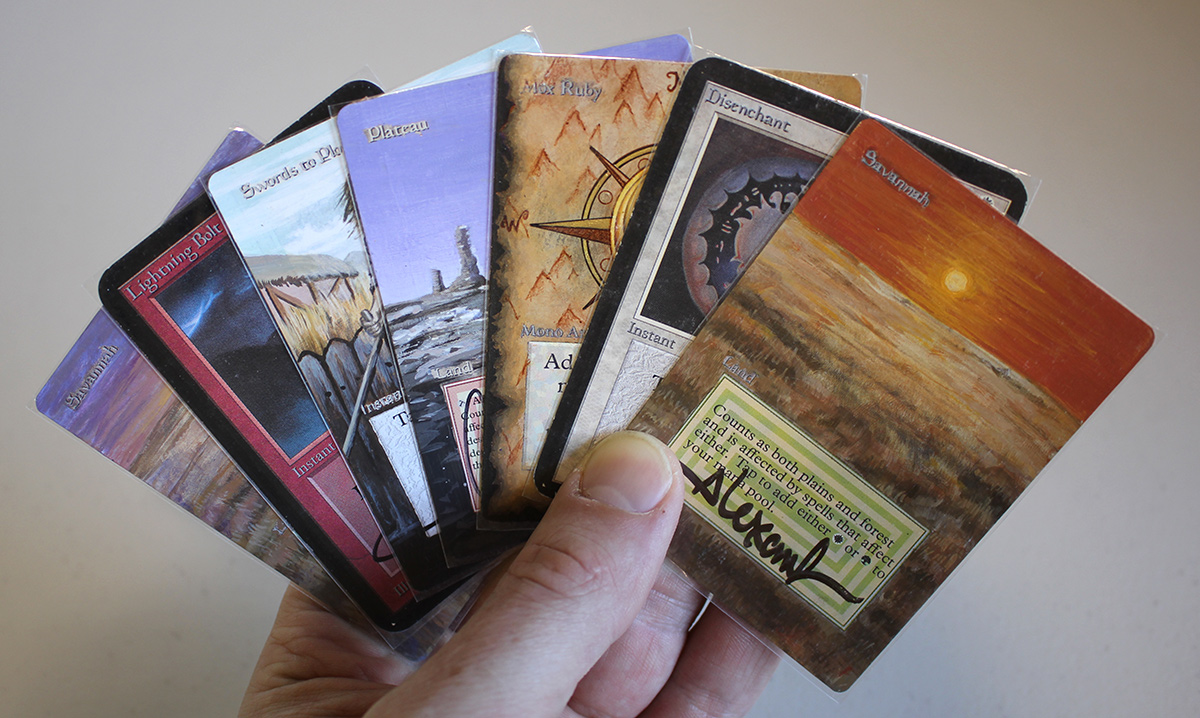
If you know what you’re playing against, this hand could either be really good, or really bad. If you’re playing against an aggressive strategy where you know this removal will be good, it’s probably a keep. Against an unknown opponent I’d probably flush it for a fresh six, and hope to hit some creatures that can be cast early.

Not a great mulligan. This hand has plenty of mana, but nothing (yet) in the way of colored sources beyond Mox Ruby. Because it features a pair of Factories (as threats), and a pair of Strip Mines (to rewind the game a turn each time potentially, and allow us to draw in to more of anything), I’d probably begrudgingly keep this. With the pre-game scry I’ll be searching for White mana hopefully.
Opening Hand 10

In contrast with the last hand, this hand features great mana, Strip Mine, removal, and a threat. It also allows you to follow up with Sylvan Library on the second turn. This is a snap keep.
Concluding Thoughts
Naya Bazaar Zoo is one of my absolute favorite decks in Old School, because it truly demonstrates the power of aggressive decks utilizing Strip Mine, and plays tons of sweet cards. It provides the challenge of not relying on the most powerful cards in the format (Ancestral Recall, Time Walk, Library of Alexandria, and Mind Twist), and also challenges you to play tightly every turn to maximize tempo and sequencing. The presence of Sylvan, Bazaar, and so much removal makes it a very skill intensive deck with a ton of decision making, and it is one of the few decks that can reliably keep up with the blue draw engines.
Stay tuned to Eternal Central for more sick 93-94 brews all month long. Thanks for reading.

